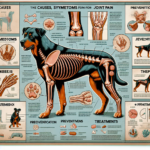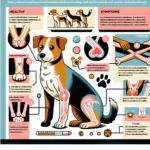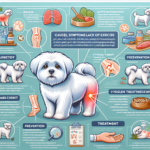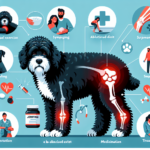Cesky Terrier Joint Pain: Causes, Symptoms, Prevention, and Treatment
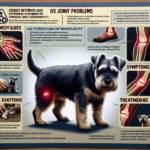
Introduction
The Cesky Terrier, a small yet robust breed, hails from the Czech Republic. Developed by František Horák in the mid-20th century, this breed was initially intended for hunting in the dense forests of Bohemia. Known for their distinctive long, silky coat and friendly demeanor, Cesky Terriers are both excellent companions and skilled hunters. Despite their relatively recent origin, they have quickly gained popularity due to their unique appearance and versatile nature.
Like many breeds, Cesky Terriers are prone to certain health issues. Among these, joint pain is a significant concern that can affect their quality of life. Understanding the causes, symptoms, prevention, and treatment of joint pain in Cesky Terriers is crucial for ensuring their well-being.
Joint health is particularly important for Cesky Terriers due to their active lifestyle and genetic predispositions. Maintaining healthy joints can help prevent pain and mobility issues, allowing these energetic dogs to enjoy a full and active life.
Breed-Specific Joint Pain Risks
Genetic Predisposition
Cesky Terriers, like many purebred dogs, have a genetic predisposition to certain joint-related issues. Hip dysplasia, a condition where the hip joint doesn’t fit properly into the hip socket, is one such concern. This can lead to arthritis and significant pain over time. Elbow dysplasia, another genetic condition, affects the elbow joint and can cause similar issues. Both conditions are hereditary and can be exacerbated by environmental factors.
Age-Related Risks
As Cesky Terriers age, the risk of developing joint pain increases. While they are generally healthy dogs, the wear and tear on their joints over the years can lead to arthritis and other degenerative joint diseases. Owners should be particularly vigilant as their dogs approach middle age, typically around 6-8 years old, as this is when joint issues often begin to manifest.
Activity Level and Joint Stress
Cesky Terriers are known for their high energy levels and love for physical activity. Whether they are hunting, playing, or simply exploring, their active lifestyle can put significant stress on their joints. While exercise is essential for their overall health, excessive or inappropriate activities can lead to joint injuries and long-term pain.
Common Symptoms of Joint Pain in Cesky Terriers
General Symptoms
- Limping: One of the most noticeable signs of joint pain is limping or favoring one leg over another.
- Stiffness: Dogs may show stiffness, especially after resting or sleeping.
- Reluctance to Move: A dog in pain may be hesitant to jump, climb stairs, or even go for walks.
- Swelling: Swelling around the joints can be a sign of inflammation and pain.
- Behavioral Changes: Irritability, lethargy, or changes in appetite can also indicate discomfort.
Breed-Specific Symptoms
In Cesky Terriers, joint pain may manifest in specific ways due to their unique build and activity patterns. Owners might notice a decrease in their dog’s enthusiasm for activities they once enjoyed, such as hunting or playing fetch. Additionally, the breed’s distinctive gait may become more pronounced or awkward as they try to compensate for joint pain.
When to Consult a Vet
If you observe any of the above symptoms in your Cesky Terrier, it’s essential to consult a veterinarian promptly. Early intervention can prevent further deterioration and improve your dog’s quality of life. Persistent limping, noticeable pain, or significant changes in behavior should all prompt a veterinary visit.
Preventive Measures for Joint Health
Exercise Recommendations
Regular, moderate exercise is crucial for maintaining joint health in Cesky Terriers. Activities such as walking, swimming, and controlled play can help keep their joints flexible and muscles strong. Avoid high-impact activities like jumping or running on hard surfaces, as these can exacerbate joint stress.
Dietary Suggestions
A balanced diet rich in essential nutrients can support joint health. Consider incorporating foods or supplements that contain glucosamine, chondroitin, and omega-3 fatty acids, which are known to promote joint health. Always consult your veterinarian before adding supplements to your dog’s diet.
Weight Management
Maintaining a healthy weight is vital for reducing joint stress. Excess weight can put additional pressure on the joints, leading to pain and degeneration. Regularly monitor your dog’s weight and adjust their diet and exercise routine as needed to keep them at an optimal weight.
Early Screening and Monitoring
Regular veterinary check-ups are essential for early detection of joint issues. Screening tests such as X-rays can help identify problems before they become severe. Early intervention can significantly improve outcomes and prevent long-term pain.
Treatment Options for Joint Pain
Non-Surgical Treatments
For mild to moderate joint pain, non-surgical treatments can be highly effective. These may include:
- Medications: Anti-inflammatory drugs and pain relievers can help manage symptoms.
- Physical Therapy: Specialized exercises and therapies can improve joint function and reduce pain.
- Lifestyle Adjustments: Modifying your dog’s activity level and environment can help alleviate stress on their joints.
Surgical Options
In severe cases, surgical intervention may be necessary. Common surgeries for joint pain include:
- Hip Replacement: Replacing the damaged hip joint with an artificial one can significantly improve mobility and reduce pain.
- Arthroscopy: A minimally invasive procedure to clean out the joint and remove damaged tissue.
- Joint Fusion: Fusing the joint to prevent movement and reduce pain in cases of severe arthritis.
Alternative Therapies
Alternative treatments can also provide relief for joint pain. These may include:
- Acupuncture: This ancient practice can help reduce pain and inflammation.
- Hydrotherapy: Water-based exercises can improve joint function without putting stress on the joints.
- Massage: Regular massages can help alleviate muscle tension and improve circulation.
Lifestyle and Management Tips
Daily Care Routine
A consistent daily care routine can help manage joint pain in Cesky Terriers. This might include gentle exercise, a balanced diet, and regular check-ups with the vet. Incorporating joint-friendly activities like swimming can also be beneficial.
Modifying the Home Environment
Making your home more comfortable for a dog with joint pain can significantly improve their quality of life. Consider adding ramps to help them navigate stairs, providing orthopedic beds for better support, and ensuring their living space is free of obstacles that could cause injury.
Long-Term Management
Long-term management of joint pain involves a combination of regular veterinary care, appropriate exercise, and a healthy diet. Monitoring your dog’s condition and making adjustments as needed can help them stay active and happy despite joint issues.
FAQs About Cesky Terriers and Joint Pain
What are the early signs of joint pain in Cesky Terriers?
Early signs include limping, stiffness, reluctance to move, and behavioral changes such as irritability or lethargy.
Can joint pain in Cesky Terriers be prevented?
While genetic predispositions cannot be entirely prevented, maintaining a healthy weight, providing appropriate exercise, and regular veterinary check-ups can help reduce the risk and severity of joint pain.
Are there specific foods that can help with joint health?
Yes, foods rich in glucosamine, chondroitin, and omega-3 fatty acids can support joint health. Always consult your vet before making dietary changes.
When should I consider surgery for my dog’s joint pain?
Surgery is usually considered when non-surgical treatments are no longer effective, and the dog’s quality of life is significantly impacted. Consult your veterinarian for a thorough evaluation.
Are alternative therapies effective for joint pain?
Alternative therapies like acupuncture, hydrotherapy, and massage can be effective in managing joint pain and improving mobility. They are often used in conjunction with traditional treatments.
Conclusion
Joint pain is a significant concern for Cesky Terriers, but with proper care and attention, it can be managed effectively. By understanding the causes, symptoms, prevention, and treatment options, owners can help their dogs lead active and pain-free lives. Regular veterinary check-ups, a balanced diet, appropriate exercise, and a supportive home environment are all crucial components of maintaining joint health. Taking these preventive measures and consulting with your veterinarian regularly will ensure your Cesky Terrier remains happy and healthy for years to come.

